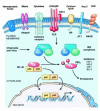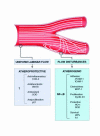NF-kappaB: pivotal mediator or innocent bystander in atherogenesis?
- PMID: 11160146
- PMCID: PMC199202
- DOI: 10.1172/JCI10373
NF-kappaB: pivotal mediator or innocent bystander in atherogenesis?
Figures


References
-
- Ross R. Atherosclerosis: an inflammatory disease. N Engl J Med. 1999; 340:115–126. - PubMed
-
- Karin M. The beginning of the end: IkappaB kinase (IKK) and NF-kappaB activation. J Biol Chem. 1999; 274:27339–27342. - PubMed
-
- Wilson SH, et al. Activated nuclear factor-kappaB is present in the coronary vasculature in experimental hypercholesterolemia. Atherosclerosis. 2000; 148:23–30. - PubMed
-
- Iiyama K, et al. Patterns of vascular cell adhesion molecule-1 and intercellular adhesion molecule-1 expression in rabbit and mouse atherosclerotic lesions and at sites predisposed to lesion formation. Circ Res. 1999; 85:199–207. - PubMed
Publication types
MeSH terms
Substances
Grants and funding
LinkOut - more resources
Full Text Sources
Other Literature Sources

